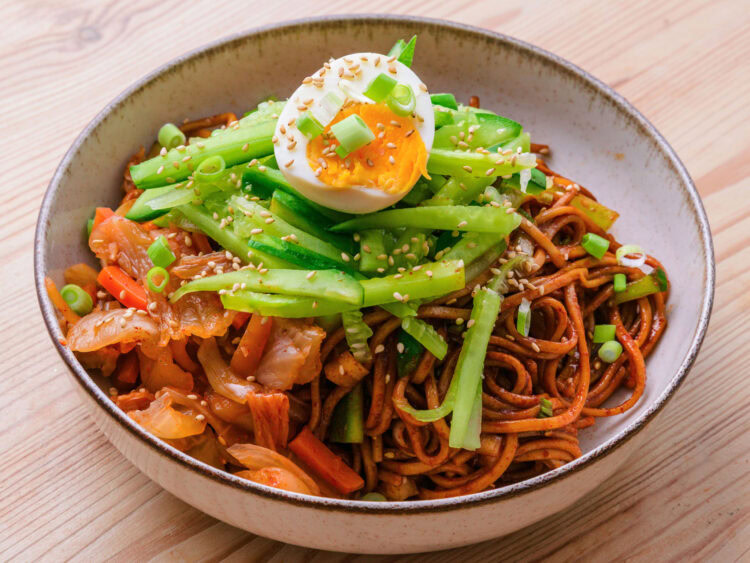Korean cold noodles tossed in a sweet and spicy chili sauce for a dish that’s both refreshing and fiery.
The first bite is a shock: Asian noodles chilled and coated in a glossy red sauce. It starts off sweet on the tip of your tongue, then the bite of fermented chili kicks in, making you sweat—even on an already sweltering afternoon in Seoul.
Fans crowd into tiny alleyway stalls to savor the contrast between icy noodles and spicy sauce, because bibim guksu captures the Korean summer like few other dishes—even though it was originally created as a delicate winter solstice treat.

At the heart of the recipe lies “balance in mixing,” a principle that carried this former Joseon dynasty court banquet specialty into the kitchens of modern Korean homes.
From Goldongmyeon to Korea’s Favorite Street Food
Goldongmyeon, the ancestor of today’s bibim guksu, first appeared in the 19th-century seasonal almanac Dongguk Sesigi. The aristocratic version wrapped buckwheat noodles in a soy-sesame sauce, with slices of pear and chestnut, sautéed beef, and confetti-like strips of thin egg crepe.
This refined creation was served at winter solstice banquets, alongside a chilled dongchimi broth to cleanse the palate. Chili was just a subtle accent, and the abundance of toppings reflected the host’s status.
After the Korean War, American aid flooded the peninsula with wheat flour. Cooks turned to somyeon, tender noodles that cook in a flash. Gochujang—cheap, long-lasting, and as spicy as you like—replaced soy sauce as the main seasoning.
By 1968, Manghyang Bibim Guksu, a humble stall near a military base, was already serving bowls to young conscripts craving calories and heat; its popularity cemented bibim guksu as affordable street food. The dish also left its winter ritual behind to become a summer staple, its icy rinse proving invaluable in the muggy monsoon heat.
Essential Ingredients for Bibim Guksu
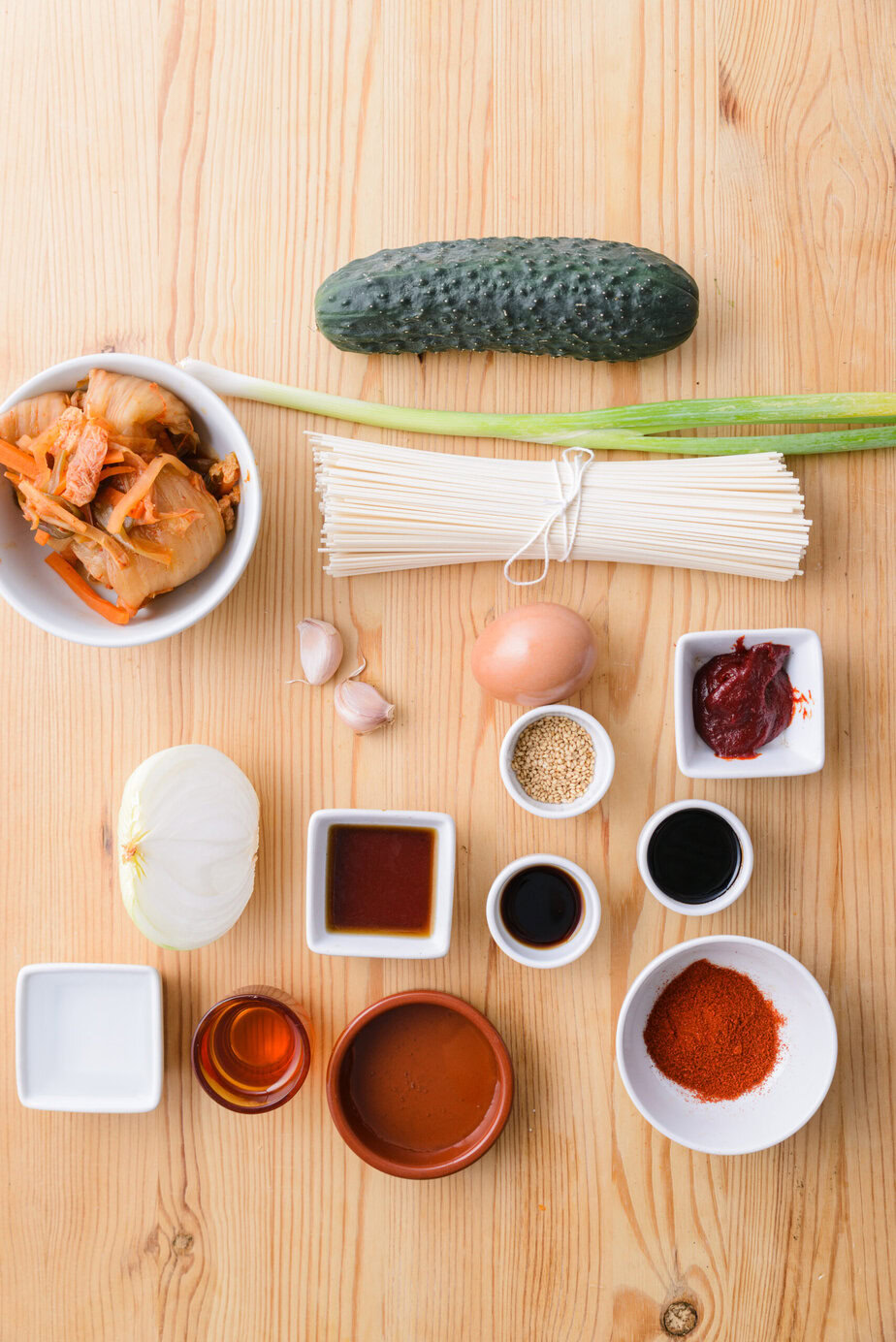
Ask ten Korean home cooks about “real” bibim guksu and you’ll spark a debate over toppings, but they all agree on the basics.
The noodles must be as thin as hair and rinsed until perfectly firm; any lingering warmth is heresy.
For the sauce: gochujang (or soy sauce, for the old-school version) brings depth, vinegar brightens, sugar smooths the edges, and fragrant sesame oil ties it all together. A crunchy counterpoint—often cucumber sticks—and a halved hard-boiled egg add texture and a gentle landing for the chili heat.
Toasted sesame seeds showered over the bowl at the last second finish the dish. Skip the vinegar and the noodles taste flat; leave out the sesame oil and the bowl feels hollow. As for anyone who suggests Sriracha or peanut butter, polite guests will smile—then quietly point out that’s a different dish altogether.
Two Classic Sauces, Endless Personal Twists
The internet’s favorite version is unmistakably red: gochujang loosened with vinegar, just sweet enough, sometimes electrified with a spoonful of kimchi brine. Yet a quiet minority stands by ganjang bibim guksu (the old soy-sesame version found in late Joseon cookbooks), whose glossy finish recalls royal kitchens and offers relief for those wary of spice. Both claim authenticity; what matters isn’t the color, but the balance.
Toppings are a free-for-all, as long as they respect tradition. Canned tuna adds effortless umami, grilled pork belly turns the bowl into a midnight meal, and finely shredded perilla leaves bring a minty freshness—common enough that few Koreans would bat an eye.
How to Serve Bibim Guksu
The process is quick but simple. Noodles go into boiling water, then are plunged into ice water to lock in their bite. They’re immediately tossed with the sauce so every strand glistens. Toppings are arranged on top, never buried, inviting the diner to mix it all together.
In Hamhung, slippery potato starch noodles—locally called hoe-naengmyeon—are topped with raw skate, whose briny flavor tempers the chili heat. Seoul’s jaengban style is served on a platter for sharing, with long metal tongs replacing chopsticks as the mixing tool of choice. Wherever you are, the side dish matters: a small glass of icy dongchimi or a sip of clear, hot soup like wanja-tang refreshes your palate, a simple hot-cold contrast.
The Cultural Symbolism of Bibim Guksu
In Korean, the verb bibim means “to mix”—a culinary philosophy that values harmony over uniformity. Bibim guksu, like its rice-based cousin bibimbap, makes this verb a metaphor: disparate ingredients, equal at the table, only finding order once stirred together.
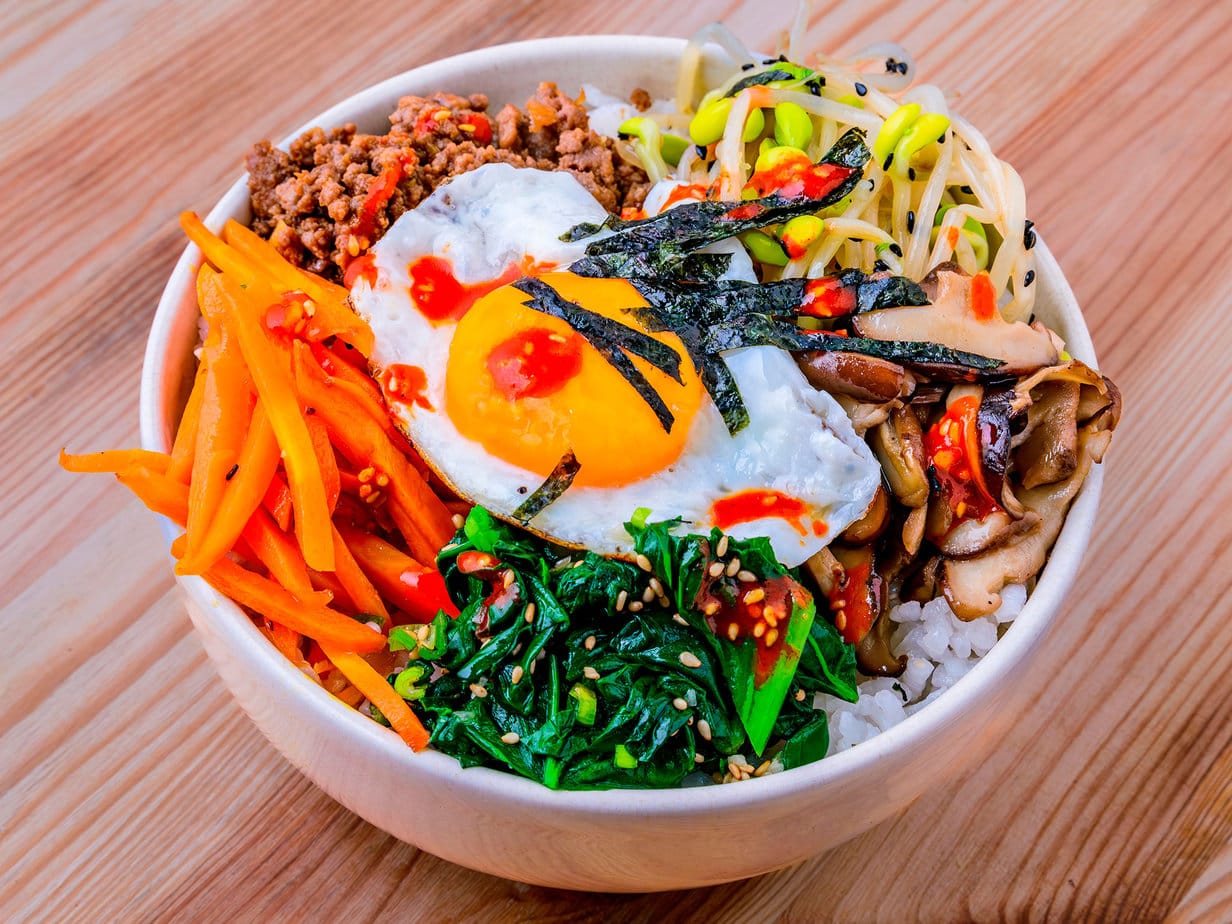
For the younger generation outside Korea, it’s often their first step into fermented flavors. Many Korean restaurants worldwide have adopted it as a signature summer dish, and some Korean grocery stores sell simplified kits for home cooking—even if purists still grumble about limp noodles.
Whether it’s served in silver court bowls or a plastic delivery cup, the dish endures for that first sensation: the chill hits, the chili warms, sweetness meets crunch, and the aroma of sesame oil ties it all together.
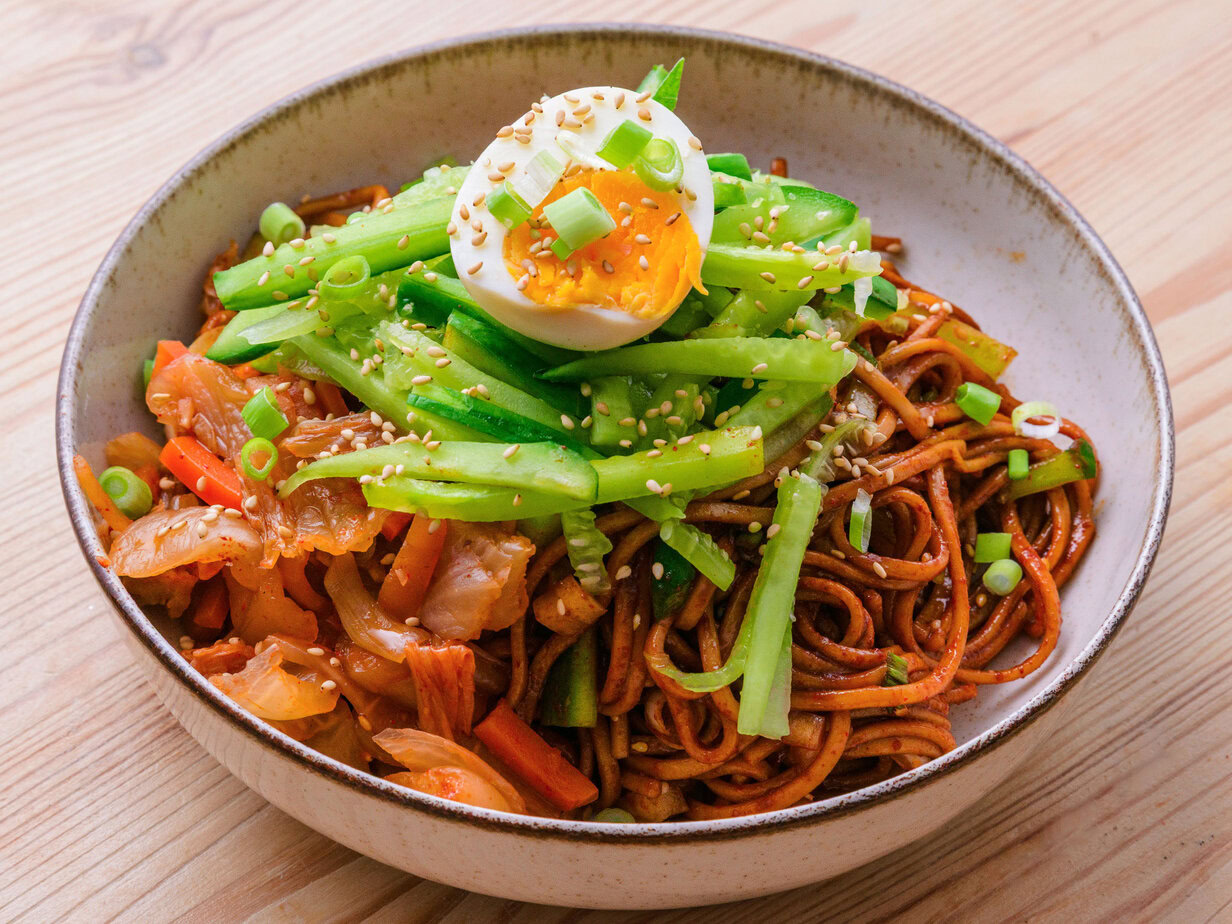
Ingredients
Noodles and Toppings
- 200 g somyeon noodles
- 1 egg hard-boiled
- cucumber julienned
- green onion finely sliced
- kimchi as needed
- sesame seeds
Bibim-Guksu Sauce
- 2 tablespoons dark soy sauce
- 1 tablespoon light soy sauce
- 1 tablespoon fish sauce
- 1.5 tablespoons gochujang
- 3 tablespoons gochugaru
- 2 tablespoons corn syrup
- 2 tablespoons sesame oil
- 1 tablespoon rice vinegar
- 1.5 tablespoons garlic minced
- 0.5 onion chopped
- long green onion thinly sliced, as needed
Cooking the Noodles
- 2 L water
- 1 tablespoon salt
Instructions
Bibim-Guksu Sauce
- Whisk together all sauce ingredients in a bowl.2 tablespoons dark soy sauce, 1 tablespoon light soy sauce, 1 tablespoon fish sauce, 1.5 tablespoons gochujang, 3 tablespoons gochugaru, 2 tablespoons corn syrup, 2 tablespoons sesame oil, 1 tablespoon rice vinegar, 1.5 tablespoons garlic, 0.5 onion, long green onion
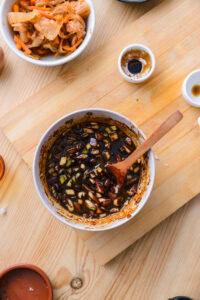
- Refrigerate for at least 5 minutes, ideally while the noodles cook.
Cooking the Noodles
- In a large pot, bring 2 L water and 1 tablespoon salt to a boil.2 L water, 1 tablespoon salt
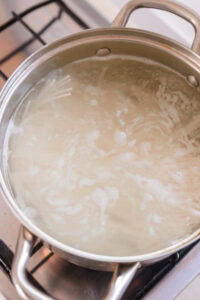
- Add the noodles and cook for 2.5 minutes. If the water threatens to boil over, add a cup of cold water. Cook until al dente.200 g somyeon noodles
- Drain, then rinse thoroughly under cold water to remove the starch and cool the noodles.
Assembling the Bibim-Guksu
- Place the drained noodles in a large bowl and add the sauce.
- Toss well until every strand is evenly coated.
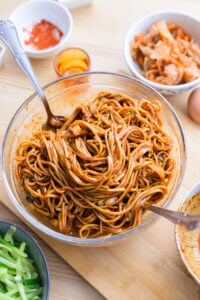
- Divide between bowls, top with the egg, green onion, and cucumber, then sprinkle with sesame seeds.1 egg, green onion, cucumber, sesame seeds
Notes
Nutrition
Culinary Sources
• Bibim guksu – Encyclopedia of Korean Culture (Korean)
• History of Korean Cuisine: Bibim Guksu – Daehan Gupsik Sinmun (Korean)
• Bibim guksu! My favorite dish for summertime 🙂 – Reddit (English)
• Bibim guksu (spicy cold noodles) – Korean Bapsang (English)
• [Why] From the same root, now strangers… Bibim guksu showdown – Chosun Ilbo (Korean)
• Ganjang bibim guksu: cold soy sauce summer noodles – Reddit (English)
• Spicy noodles with peanut butter and kimchi – Food52 (English)
• Soy sauce bibim guksu – Aeri’s Kitchen (English)
• Korean noodles – Wikipedia (English)
• First time: bibim guksu – Reddit (English)
